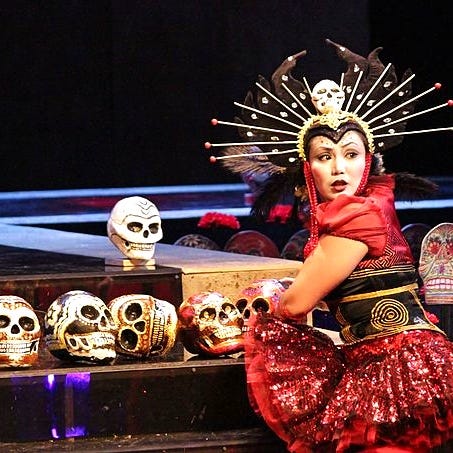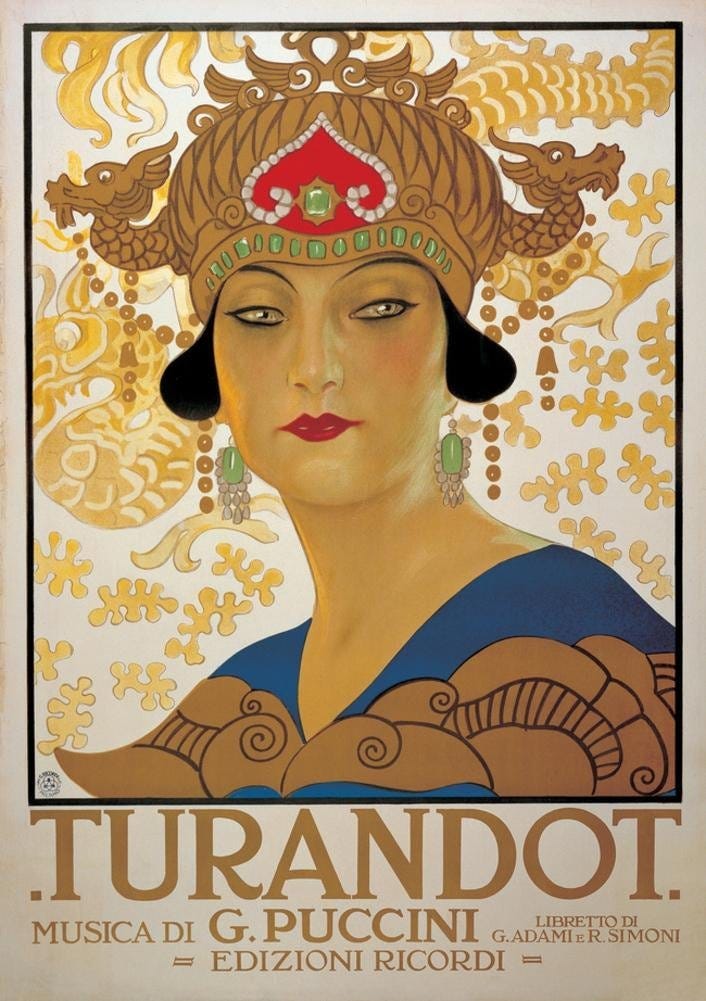If you ask any Italian to name his country’s most beloved composer, he would be hard pressed to choose between Giuseppe Verdi (1813–1901) and Giacomo Puccini (1858–1924).
Verdi was the classic romantic genius of Italian opera. Even the non-initiated might recognize the names of a few of Verdi’s more famous compositions—Rigoletto, La Traviata, and Falstaff.
I found out that he wrote an opera about St. Joan of Arc, which definitely bumps Verdi up on my list of favorites!
But Puccini followed in his wake and had no rival in his era. The names of a few of Puccini’s works are equally recognizable, even to those not very familiar with opera. He composed Madame Butterfly and Tosca and La Bohème, among others.
But perhaps the best of his operas was his last, the one he left unfinished: Turandot (the final “t” is silent), which we’ll speak about below. First, a note about Puccini’s rare genius.
An Inheritance of Musical Talent
Puccini was an enormous talent and a prolific composer of all types of music. In addition to his 12 romantic operas, he composed 20 art songs, five orchestral works, five piano pieces, and another half dozen chamber and choral pieces.
He was 65 when he died, so I’d say he has a lot to show for his long career in music.
One reason why such incredible talent exuded from him was his pedigree. The Puccinis were literally a musical dynasty. He came from a line of church musicians that stretched back five generations!
His great-great grandfather (also named Giacomo) became the choir master for the cathedral church of San Martino in Lucca, Italy in 1740, and his family didn’t relinquish the position for 124 years!
Giacomo was succeeded by his son Antonio, who was succeeded by his son Domenico, who was succeeded by his son Michele.
As bad luck—or perhaps Providence—would have it, Puccini’s father Michele died in 1864 when Giacomo was only six years old and unable to carry on the church music tradition.
But it’s not hard to see why Puccini was the great composer he was. Each generation of talent seemed to build on the previous one and ultimately produced Italy’s greatest romantic artist. The music was in him.
Without the promise of a church career, he pursued other avenues to express his musical talent. We could say that the world of high culture benefited from the cathedral of Lucca’s loss.
Turandot
It’s not my purpose here to recount his life story (which was every bit as dramatic as his operas!) I’d just like to give you a backdrop to the amazing, and I mean amazing, aria in the final scene of Turandot.
The opera is essentially a dramatization of a Chinese folk tale featuring a notoriously unpleasant—but beautiful—ice princess named Turandot and the mortal drama surrounding her suitors. Here is how the Wikipedia article summarizes the scene:
It is sung by Calaf, the “unknown prince”, who falls in love at first sight with the beautiful but cold Princess Turandot. Any man who wishes to wed Turandot must first answer her three riddles; if he fails, he will be beheaded. [Yikes!] In the aria, Calaf expresses his triumphant assurance that he will win the princess; [however,] the cruel and emotionally cold princess then decrees that none of her subjects shall sleep that night until [one victor emerges]. If they fail, all will be killed.
This explanation provides the rationale for two elements of the aria:
The stunning high note occurs on the last word, “vinceró” (Calaf’s passionate declaration, “I will conquer”) on which the singer sustains the final two syllables “EEEEEER-oooooooo!” for at least ten seconds (get ready: it sends chills down the spine);
The name of the aria is Nessun Dorma, which means “no one shall sleep” (or “let no one sleep”).
Would you sleep if you knew that a wicked princess was awake in her palace sharpening her blade to cut off your head in a few hours?


The Completion
Puccini had finished two of three movements of Turandot by 1924 when he was diagnosed with throat cancer due to a lifelong habit of chain smoking. In October of that year he went to Brussels for surgery but died a few days later of complications that led to a heart attack.
Perhaps he had a clear intuition of his upcoming demise because before he left for Brussels, he entrusted the operatic score and composition notes to his friend, the great Italian conductor Arturo Toscanini, and pleaded with him, "Don't let my Turandot die."
Toscanini was a friend both in deed and in truth. He sought out capable artists who would finish the opera according to Puccini’s specifications. Then he conducted the premier performance at La Scala in Milan on April 25, 1926, a year and a half after the great composer’s death.
The Final Tribute
Toscanini made one dramatic flourish in the opener that will never be forgotten. Since Puccini had cut short his work in the middle of Act III to seek medical attention, Toscanini stopped when he reached that point in the opera and uttered these words,
"Here the Maestro laid down his pen."
And with that, the curtain was lowered. Talk about a show stopper!
The second and all other subsequent performances included the ending that had been added after Puccini’s death by lesser mortals.
------------------
Below I have placed links to three performances of Puccini’s Nessun Dorma by three famous tenors of the 20th and 21st century. (Each performance is just over 3 minutes.)
Any one of them will knock your socks off, but if you have about ten minutes to listen to all three, I’d ask you to take the one-question survey to let me know which one you think is the best. (Click the button at the end to cast your vote.)
In my humble opinion, extraordinary talent like this (from composer to conductor to musicians) is a wide-open window of amazing grace.
------------------
Luciano Pavarotti (3:15)
Jonas Kaufmann (3:24, watch for the smile at the end)
Placido Domingo (3:06, on the opera stage)
Photo Credits: Feature-Calaf (Cuibar); Turandot 1 (Cia de Teatro Katarriso); Turandot 2 (Аркадий Зарубин); Puccini (Public Domain); Poster (Leopoldo Metlicovitz).









Thanks for sharing such an interesting story, Love this 🥰🥰🥰
I am woefully ignorant of opera but I do have a favorite YouTube selection.
https://www.youtube.com/watch?v=BSPuY-YLe-w
1:25:54 video runtime
The Three Tenors LONDON 1996 (FULL CONCERT) REMASTERED VIDEO & AUDIO
9,896,998 views Mar 7, 2016
James Levine conducts and The Three Tenors perform at Wembley Stadium, London in July 1996 (FULL CONCERT).
Luciano Pavarotti
Placido Domingo
Jose Carreras
____________
also I recommend Elisey Mysin YouTube channel of Russian child piano prodigy.
Here is a precious one.
https://www.youtube.com/watch?v=oxq-khtwMHg
3:41 video runtime
Tchaikovsky, Waltz Of The Flowers I Elisey Mysin, Agafya Korzun 2019
Elisey Mysin
365,453 views
___________
Here is a little personal anecdote about Pavarotti.
Years ago, my brother-in-law was in his MD Ear Nose Throat residency training in New York City when Pavarotti held a concert. Their professor asked Pavarotti if he would come and talk with a few of his residents and Pavarotti said yes. He cordially answered questions about his voice and how he trained and took care of it, but when the doctors asked to examine his throat, Pavarotti declined.